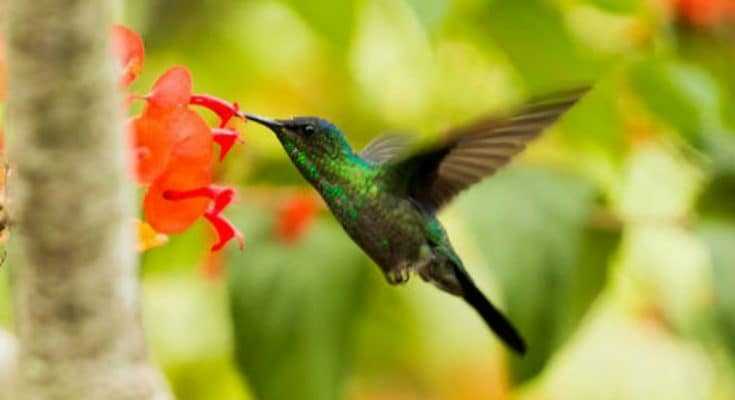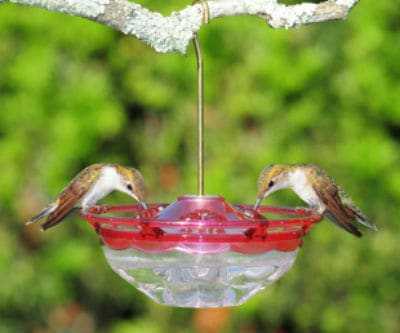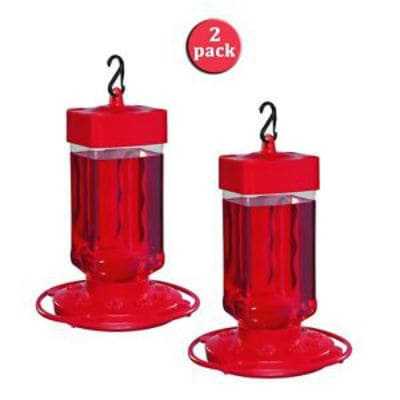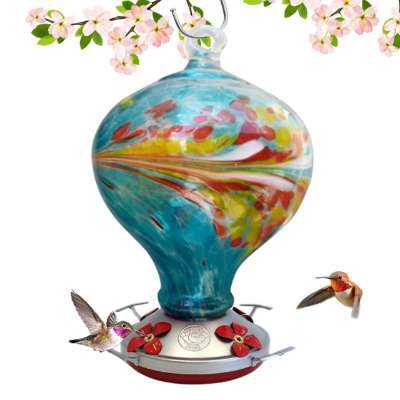Hummingbirds are perhaps the daintiest birds whose presence is the most desired among gardeners and bird-watchers alike. Every spring millions of Americans hang bright red feeders filled with sugar water to attract the lovely flying creatures, and many gardeners set out plants and flowers whose bright hues and fragrant aromas encourage hummingbirds to them.
These extraordinary birds are not purely ornamental, however. Hummingbirds are exceptional pollinators, as well, transferring pollen necessary for fertilizing many of the foods on which we depend. Many plants and flowers that attract the more popular pollinators such as bees and butterflies also attract hummingbirds, while feeders are designed to attract only a variety of hummingbirds
Hummingbirds
As pollinators, hummingbirds play an important role in the food chain. Some plants are designed to only be pollinated by hummingbirds. Like many birds, most hummingbird species often migrate depending on climate, so they need to stop for nourishment along the way.
There are over 300 species of hummingbirds, and all of them depend on nectar. So, when planting a pollinator garden for the express purpose of attracting these little birds it is necessary to include nectar rich flowers. Another great way to lure hummingbirds into the garden is by hanging a hummingbird feeder nearby.
Nesting hummingbirds are fascinating to observe. These tiny creatures construct their nests using materials such as spider webs, which provide flexibility as the nest expands to accommodate growing chicks. You can enhance your garden’s appeal to nesting hummingbirds by incorporating plants that offer not only nectar but also structural support, like sturdy branches or trellises where they can weave their delicate nests.
Consider providing additional shelter for nesting hummingbirds by installing bird houses in strategic locations around your garden. These houses mimic natural nesting sites and offer protection from the elements and predators. To create a truly inviting habitat for these charming birds, make sure your garden offers a variety of nectar-rich blooms, suitable perching spots, and even potential materials like spider webs for their nest-building endeavors. By creating a harmonious environment that addresses their feeding, nesting, and shelter needs, you’ll be fostering a haven for hummingbirds in your own backyard.
Hummingbird Feeders
Since red is the color that attracts hummingbirds the most, a variety of commercial red feeders are available for purchase from a variety of big-box and online retailers.
Hang the feeder in or near the garden at least three feet off the ground. Make sure it is in a shaded area to attract more little birds. Fill the feeder with purified water and add 30% sugar.
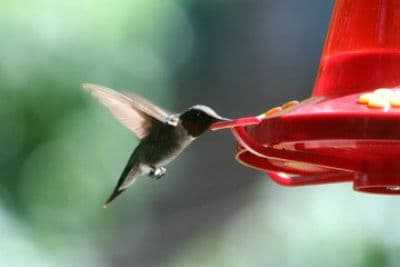
For instance, if the feeder holds one cup of water, add almost 1/3 cup of sugar. Do not add artificial sweeteners, brown sugar, or honey. All it needs is water and white sugar.
Be sure to clean and replace the sugar water periodically.
If the water looks foggy it is probably growing bacteria or fungi and needs to be replaced.
Bird Baths
Like any animal, hummingbirds also need water to survive. While they get most of their water from nectar rich plants, they are also attracted to plain water. Placing a bird bath or fountain in the garden is a good way to attract more hummingbirds.
Hummingbird Garden Flowers
Like many pollinators, hummingbirds are especially attracted to native plants and flowers to meet their nectar needs. Consider setting out an ideal hummingbird garden with tubular flowers, as these specialized blooms are particularly appealing to these dainty birds and aid in their nourishment and pollination processes.
The Trumpet Creeper is somewhat similar in shape and color to the Cardinal Flower. Hummingbirds love this bloom so much, it is sometimes called “Hummingbird Vine.” In addition to its red color and aromatic nectar, hummingbirds are also attracted to the Trumpet Creeper’s shape, which easily accommodates their long beaks and long, rolling tongues
Cardinal flowers, as their name implies, have a bright red hue and are also indigenous to North and South America. Their long tubes are a perfect fit for the hummingbirds’ long beaks and their nectar is well-suited for the hummingbird’s nutritional needs.
Wild Bergamont, also called bee balm, comes in shades of pink and purple. Wild Bergamont is a hardy wildflower that should bloom all season long.
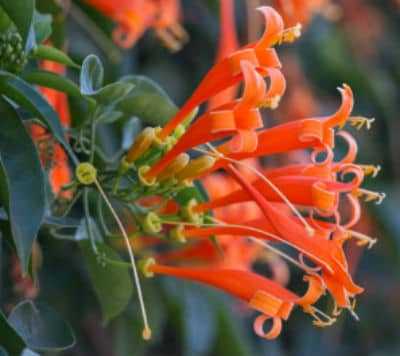
Trumpet Honeysuckle is indigenous to North America. This variety of honeysuckle has a vibrant coral color that attracts hummingbirds, as well as butterflies and bees.
Trumpet honeysuckle is easy to grow and is less invasive than other honeysuckle varieties.
A bonus to planting this favorite bloom is the sweet aroma that is usually just as pleasant for people.
Hummingbird Feeder Reviews
Since hanging hummingbird feeders with sugar water is a great way to attract hummingbirds to pollinator gardens, we have rounded up some of the most popular commercial feeders to review!
Aspects HummZinger Hanging Hummingbird Feeder
The Aspects HummZinger Highview 12-ounce Hanging Hummingbird Feeder is a simple, disc-shaped feeder. Its bright red color is a great way to catch hummingbirds’ attention. It also has a ledge around the edge for the birds to perch comfortably.
It features four feeding ports for the birds to reach the sweet food sources inside. The Aspects HummZinger also features a removable bowl so that it can be cleaned easily.
Its durable polycarbonate material also makes it unlikely to break in the event that it gets knocked down by strong winds or by another animal
It is available for purchase at Amazon.com for around $25-30 with the option of free shipping.
First Nature Hummingbird Feeders
The First Nature 1051 Hummingbird Feeders comes with two 16-ounce classic hummingbird feeders.
An upright cylindrical container holds the nectar and it is attached to a two-part base with a removable feature. A unique sealing ring is built in to prevent the sugar water from leaking.
The feeders are vibrant red, which hummingbirds can see from a distance.
They also feature 10 feeding ports to accommodate many birds at one time. An “S”-shaped hook makes hanging and removing the feeders for cleaning a simple process.
These First Nature Bird Feeders are available as a set of two, making them one of the more cost-effective options, as well.
The Grateful Gnome Hummingbird Feeder
The Grateful Gnome Hummingbird Feeder is an artistically designed feeder made from hand-blown glass. It holds 36 ounces of sugar water and features an array of bright colors to which hummingbirds are attracted.
This Hummingbird Feeder would make an elegant addition to any pollinator garden. With four feeding ports on which hummingbirds can perch.
Its glass threading provides a secure way for the feeder to hang from wire or a plant hanger. Consider placing this feeder near a window or in a pollinator garden.
Songbird Essentials Copper Hummingbird Swing
The Songbird Essentials SEHHHAMS Copper Hummingbird Swing may make a whimsical addition to any flower garden.
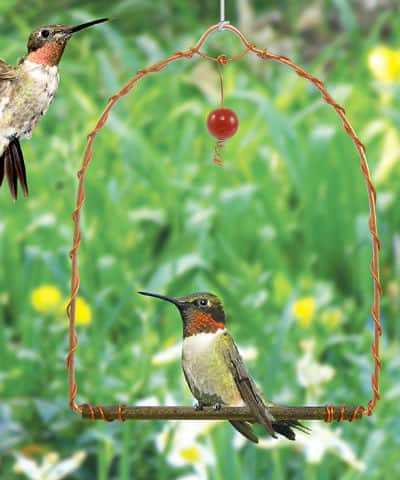
It features a copper arch with a wooden perch on the base. A bright red glass orb hangs from the top to draw hummingbirds to it.
The small perch is the perfect size for hummingbirds to grip easily.
The Songbird Essentials Swing is an affordable option for many consumers at around $10-12.
Consider placing the swing near a hummingbird feeder as a place for them to rest between feedings or on a migratory route.
Lakeside Collection Globe Hummingbird Nesters – Hummingbird Garden Decor
The Lakeside Collection Globe Hummingbird Nesters come as a set of two nesters which feature a natural, woodlands design.
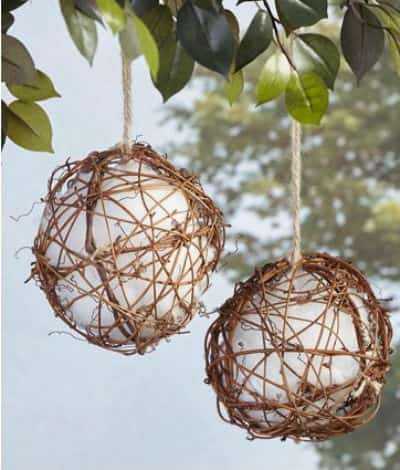
The spherical nesters are made of twig-like materials that encase a ball of all-natural cotton fillers on the inside. There are many openings in the twigs which make it easy to refill. The nesters are 6 ½ inches in diameter.
Hanging loops attached to the nesters make it easy to hang them near hummingbird feeders or in the pollinator garden as a place for the tiny birds to perch and rest while they are feeding.
The set of nesters is available for between $15-18 with the option of free shipping, making it a cost-effective option for many hummingbird aficionados, as well.
Conclusion
While often considered ornamental, hummingbirds play a valuable role in the ecosystem as pollinators. It is common to hang hummingbird feeders to attract the dainty birds while spectators enjoy their displays, but consider planning a hummingbird garden with a few flowers that nourish them and help them carry out their roles as pollinators, as well.
